A big part of using Twitter for business is to build your brand’s know, like, and trust factor through online engagement, which indirectly helps sales.
But what is engagement, why is it important, and how do you go about it?
What is Engagement?
According to Sprout Social, social media engagement is a long-term relationship with your customers that requires an open line of communication over a period of time. The interaction builds trust, brand loyalty, and improves the customer experience, possibly leading to increased chances of future purchases.
I think of social media engagement as online, personal interactions and conversations that help build your brand while also building relationships.
Why is Engagement Important?
People use Twitter to socialize, entertain themselves, and read the news—not to read promotional tweets. Thus, to be successful on social media, you can’t directly sell to your audience.
Instead, engage in relationship building and deliver valuable content. Engagement paves the way to introducing your products and services in a non-salesy way later in the customer journey.
Twitter engagement offers numerous benefits for your business, such as:
- improving reputation;
- increasing perceived authority;
- elevating social proof and trust;
- boosting offer awareness;
- amplifying influence;
- improving social scoring;
- differentiating your business in the market; and,
- attracting people to your brand.
Engagement is too important to be ignored in your social media strategy!
Here are a few ways to master Twitter engagement that will help your business.
How to Become a Pro at Twitter Engagement
Remember this rule of thumb: interacting with people on Twitter is not much different than communicating and forming relationships in person. The same etiquette applies but in an online environment.
1. Respond to Mentions
Twitter isn’t about simply tweeting out your blog links. It requires conversations to work as a social media marketing tool.
So, when someone addresses you with a comment or question, reply just as you would in person. Don’t ignore your Twitter audience!

The most obvious opportunities to respond come from direct mentions, comments, and questions aimed at you and your business. Respond to those who:
- Mention you
- Share your blog
- Retweet you
- Comment on your tweet
Don’t be afraid to be yourself.
Reply like you would in person but be aware that the written word lacks verbal and physical cues. As such, add emojis, GIFs, or images to help convey your tone.
Text lacks verbal and physical cues. Use images, emojis, GIFs to convey tone in tweets.Click To TweetEven a simple “thank you” proves that you’re paying attention and you care. Responding shows you are a real, authentic, genuine, respectful person who is invested in relationships. Not responding has the opposite effect.
Check out how Lowe’s Home Improvement engages with others. They pay attention to keywords and mentions so that they know even when people don’t @ tag/mention them. Then they reach out and partake in human to human conversations.
2. Reach Out to Others
Be proactive! Go beyond responding by taking the first step to reach out to others.
Think of it as going up to an unfamiliar person at a networking event and introducing yourself. Start with a common interest, goal, or fact.
Review people’s bios, pinned tweets, and tweet content to learn more about them. Then say hello and start a discussion on Twitter just as you would in person.
Finding people with whom you want to engage is as simple as searching within Twitter. Use keywords or hashtags to discover accounts in your industry and what your potential customers are tweeting about.
Create a Twitter list with the accounts you want to engage with frequently. Lists help you organize your Twitter engagement.
I use a Twitter list to stay in touch with my “Awesome Tweeps”—those people who frequently retweet me and show kindness on a regular basis. Once a day I access this list to say hello or retweet from these accounts.
Develop lists of industry leaders, customers, leads, specific hashtags, and colleagues. This way, you can track what’s going on within each list group and easily reach out on a regular basis.
Here are some suggestions for reaching out to others:
- Retweeting
- Retweeting with a comment
- Replying to a tweet with text or video
- Tweeting a person directly
- Tagging people in tweets and photos (when appropriate)
3. Contribute to the Conversation
Being part of a conversation gets you noticed, highlights your authority, and provides value to others. That’s why contributing to Twitter conversations is incredibly meaningful to your business.
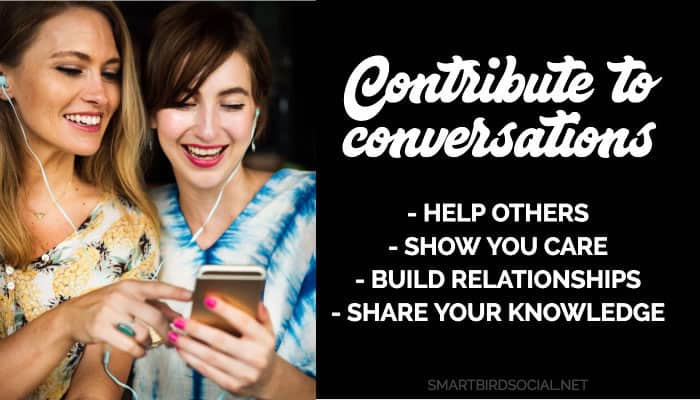
Finding relevant conversations on Twitter is like attending the right networking events. Find the places where you need to be, and invest your time where it makes the most sense.
Twitter chats are a terrific way to converse with others online about a common interest. Your participation should provide value, grow your authority, and expand your reach while fostering existing relationships.
You can also try using Twitter’s advanced search functionality to discover conversations happening on the platform.
Using the advanced search feature requires some finesse to join conversations. Remember your manners! Be polite when involving yourself in other people’s conversations. You don’t want to come across as rude or intrusive.
To insert yourself into an existing conversation, be tactful—just as you would be in person. This reminds of a saying we used as kids when people butted into our conversations:
“This is an A and B conversation. C you later!”
Inserting yourself into conversations may feel awkward. You might even feel like an outsider. However, Twitter is a very public platform, so people are used to others popping in on their discussions. Don’t be shy!
4. Be Personal
One of the best ways to differentiate yourself from your competitors is to engage as yourself.
People are on social platforms to connect with others and be social. That’s why showing up as yourself is so powerful. It’s easier to build relationships online when people know they are talking to another human, not just a logo.

You know that to increase sales on social media requires sharing the personal stuff because that’s what attracts people to you. When you’re engaging as yourself on Twitter, act like you normally do when meeting people for the first time and having conversations.
There’s no one quite like you! Take advantage of that fact. You’ll attract more relevant fans on Twitter when you’re being yourself!
Twitter Engagement Tips
Now you’re ready to engage on Twitter to boost your business! Just in case you’re still worried about how to use Twitter engagement to form relationships, here are some final suggestions.
- Engage to provide value—not to make a sale.
- Use first names to personalize your tweets and come across as friendly.
- Use emojis and images to express emotion so people understand you better.
- Share the kindness that others show to you.
- Be generous with your engagement.
- Remember: your customers are on Twitter to be social, not to be sold to!
Twitter Engagement is Only One Piece of the Puzzle
Hopefully, you now have a starting point for Twitter engagement. The more you do it, the better you’ll get at it.
Remember that relationships take time and effort. And social media is ALL about relationship building and forming connections that eventually lead prospects into your sales funnels.
If you’re using Twitter for marketing, then be prepared for a long-term commitment because social selling requires more than just tweeting. Your audience wants to see that you’re invested in them as humans versus using them for quick sales.

I appreciate your recommendations. I indeed see the value in engaging. I have to keep myself caught up. Too many things to do when you are in social media.
Twitter engagement is indeed very important to form connections, have conversations that bring you to know new people, have new opportunities, etc.
Meghan, as always you provide such valuable information! I have gotten better with my engagement on Twitter but I know I need to do so much better! I am definitely going to take your advice here on many points and make sure that I schedule Twitter engagement on my daily calendar!
I use twitter and need to increase my engagement on this platform. I respond to questions and answers and retweet. I’ve been thinking about hosting a twitter chat and reading your article puts this on the forefront for me now.
I really don’t use twitter much. I hadn’t found it to be where my target audience is. But will be keeping this for future, if that changes because this was really helpful in understanding how to engage.
Hi Meghan, I do post a lot on twitter but I’m not been big on twitter engagement because of the time it takes to keep up. You’ve certainly given a lot of good suggestions and tips that make me consider upping my engagement. Will be looking forward to learning more about your Twitter Marketing System. Great comments btw.
I too had dug in my heels with Twitter and likely because it was so fast and I was behind the curve… however, the cool thing, unlike other platforms is the search function and EVERYTHING has the opportunity to be seen. I have started working on engagement better and I do believe a few of my blogs are getting comments because of Twitter, definitely NOT Facebook, the filter king! URGH
Hi Meghan,
My Twitter account is on life support. When I first created my account in 2009, it was thriving (after a lot of hard work). Then ‘life’ interrupted my business for several months and when I returned to Twitter….crickets. So now I just post an image now and again.
Here’s a question. When my twitter account was small, it was easy for me to acknowledge all of the RTs, mentions and thanks for the follows (and even do those myself.) Now that my account is larger, I get enough of those that I would be tweeting a lot of those. I find it distracting to see that on someone else’s page because I want to see their content rather than a ton of “thanks for the follow” messages.. Do you have a suggestion?
Hey Meghan 🙂
Awesome tips for better Twitter engagement!!
Thanks so much for sharing how easy it is to be engaged and for the reminder to up my game on Twitter 😉 I spend so much time on FB that I do not realize that I can do the same with Twitter….smart tips!
As always, you give such great suggestions. I find that I don’t have a lot of time to interact with people on twitter. I realize I need to know my limits and use one platform at a time. This is where hiring a Social Media specialist would be a good idea.
Everyone raves about Twitter. Everyone but me. I have an account and I post to it, and used to engage all the time but no more. I just don’t have the time or the energy. But to those who use Twitter successfully, I say, “Good for you. Keep it up!”
Not everyone loves Twitter or uses the platform in their social media marketing strategy. I use Twitter almost exclusively because it makes sense from a business and personal goals perspective. Time and energy are required for any marketing effort, although I will say our Twitter Marketing System is an awesome, proven way to use the platform while still keeping your sanity and having time left to get things done. Thanks for your comments, Jackie.
there are so many great tips here. I have been good about responding to retweets.. so it’s a start! I think Twitter lists offer a great way to choose the people that seem most likey for more engagement. Still haven’t done any chats yet but suppose this is next on my list to try!
Twitter is a great option for your jewelry business Alene! I’m happy to hear you’re using it. Thanks Alene!
Lots of great tips here Meghan. So many people are straight to the sale on Twitter. I think more so on Twitter than any other social platform. The funny thing is, that creates an opportunity. While others engage in spamming, you can be genuinely connecting and engaging with people. You stand out that way for all the RIGHT reasons.
I noticed that too, Clive…straight to the sale, which doesn’t work at all on Twitter. Good point about other people’s mistakes being opportunities–I like that! Appreciate your comments and compliment, thank you. 😉
I hope to be more active on Twitter, I am starting to like it more and more. I love your suggestions and although I don’t think selling per se is a bad thing – afterall we are always selling something – like ourselves – it is just the way we think of it that is what is misleading. Thanks for the great info.
With your niche, Teresa, you could do so many things on Twitter that would attract people to you. You often write motivational, inspirational pieces which work so well on Twitter. Taking snippets of your blogs, adding graphics, and tweeting frequently would increase your visibility and reach. Happy to hear you’re liking Twitter–not everyone does. As for selling on any social media platform, it requires balance, subtlety, and a bit of finesse. 🙂 Thank you Teresa!
What a great post! I am still learning abut Twitter, and this was extremely helpful. Will be bookmarking this for a deeper dive!
Good to hear, Robin! Thanks for stopping by and commenting. 🙂
Although I love Twitter, I could do a lot more to be building relationships there. The fact is, I find social media incredibly time consuming and I haven’t wanted to invest more time than I am. I do keep conversations going with people who engage with me, however, I haven’t created lists or actively searched for people there. A question, Meghan. If I am sharing info about one of the USANA products to educate people, is it okay to say something like Find yours here… and then put a link? Or are you suggesting we only share info and educate without giving them a way to purchase it? I don’t think that is what you mean when you say not to ‘sell’ on Twitter. Thanks for the wonderful tips and my next step is to integrate them.
Social media can be very time-consuming, Beverley! Many small businesses and solo entrepreneurs don’t invest in social media marketing because they don’t have the money, time, or desire to use it as a channel. Often they don’t see the value since social media isn’t a quick win and may not result in direct sales. To answer your question, yes, I think it’s okay to do what you propose. I recommend that only 10-20% of your tweets be sales-related. Social media is all about the relationship. I think that selling from your website is a better option. So, use Twitter to send traffic to your site for free information and value then pitch the sale on your site. That’s what I mean about not selling on social media. Our Twitter Marketing System is so easy to set up, saves massive time, and has proven to drive traffic. We’re launching a course on it soon if you’re interested. 🙂 Thanks for such a detailed response, I appreciate you!
Can I say Amen to this! I always say it’s not called Social Selling for a reason. You’re supposed to be social. What I think is difficult is that many people are used to a traditional marketing approach and want to use a megaphone to shout out how wonderful they are or constantly try to sell the product and service. Once they tone it down, and actually have a conversation then they start to realize why and how to put the social into social media!
Yes, Crystal, you are so right! (You just gave me an idea for a blog topic, thank you!) Traditional marketing is quite different from social media marketing. Many of the solo entrepreneurs and small business owners with whom I speak want quick results with little investment. As you know, not gonna happen! 😉 Thanks for your passionate comments, I enjoyed them!
Meghan,
Great article on how to approach Twitter and talk to other’s for social engagement and making contacts. Twitter was one of the first social media platforms I started with and now am On three of them.
Thank You,
Lori English
Meghan, I’m not active on Twitter just now, but reading this makes me wish I was. I know it’s probably a good place for me to engage but I am unable to do it justice at this point in time. I’ll keep your advice in mind though when I decide to jump in.
Great how-to, Meghan! Funny enough, in the publishing world, agents and editors used to want to see big social-media-follow numbers. Now, they want to see engagement. Just one industry proving your point!
This is so important Meghan. So many businesses out there don’t talk to their audience, don’t converse in any way. It’s about being real and talking to people daily.